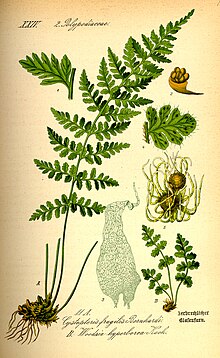Woodsia
| Woodsia | |
|---|---|

| |
| Woodsia alpina[2] | |
| Scientific classification | |
| Kingdom: | Plantae |
| Clade: | Tracheophytes |
| Division: | Polypodiophyta |
| Class: | Polypodiopsida |
| Order: | Polypodiales |
| Suborder: | Aspleniineae |
| Family: | Woodsiaceae Herter[1] |
| Genus: | Woodsia R.Br.[1] |
Woodsia is a genus of ferns in the order Polypodiales. In the Pteridophyte Phylogeny Group classification of 2016 (PPG I), it is the only genus in the family Woodsiaceae, placed in the suborder Aspleniineae.[1] The family can also be treated as the subfamily Woodsioideae of a very broadly defined family Aspleniaceae sensu lato.[3] Species of Woodsia are commonly known as cliff ferns.[4]
Taxonomy
Woodsiaceae formerly included the members of the families Athyriaceae and Diplaziopsidaceae, but analysis has consistently shown that they should be treated as separate families.[5] The following cladogram for the suborder Aspleniineae (as eupolypods II), based on Lehtonen (2011),[6] and Rothfels & al. (2012),[7] shows a likely phylogenetic relationship between the Woodsiaceae and the other families of the Aspleniineae.
| Aspleniineae (eupolypods II) | |
Species
There are about 40–50 species of the genus Woodsia.[1] As of December 2019[update], Plants of the World Online accepted the following species:[8]
- Woodsia alpina (Bolton) Gray – alpine woodsia
- Woodsia andersonii (Bedd.) Christ
- Woodsia angolensis Schelpe
- Woodsia appalachiana T.M.C.Taylor
- Woodsia asiatica Kiselev & Shmakov
- Woodsia burgessiana Gerrard ex Hook. & Baker
- Woodsia calcarea (Fomin) Shmakov
- Woodsia canescens (Kunze) Mett.
- Woodsia cinnamomea Christ
- Woodsia cochisensis Windham
- Woodsia cycloloba Hand.-Mazz.
- Woodsia cystopteroides Windham & Mickel
- Woodsia elongata Hook.
- Woodsia fragilis (Trevis.) T.Moore
- Woodsia glabella R.Br. – smooth cliff fern
- Woodsia gorovoii Krestsch. & Shmakov
- Woodsia guizhouensis P.S.Wang, Q.Luo & Li Bing Zhang
- Woodsia hancockii Baker
- Woodsia heterophylla (Turcz. ex Fomin) Shmakov
- Woodsia ilvensis (L.) R.Br. – oblong woodsia, rusty cliff fern
- Woodsia indusiosa Christ
- Woodsia kangdingensis H.S.Kung, Li Bing Zhang & X.S.Guo
- Woodsia lanosa Hook.
- Woodsia macrochlaena Mett. ex Kuhn
- Woodsia macrospora C.Chr. & Maxon
- Woodsia manchuriensis Hook.
- Woodsia mexicana Fée
- Woodsia microsora Kodama
- Woodsia mollis (Kaulf.) J.Sm.
- Woodsia montevidensis Hieron.
- Woodsia neomexicana Windham – New Mexican cliff fern
- Woodsia nikkoensis H.Ogura & Nakaike
- Woodsia oblonga Ching & S.H.Wu
- Woodsia obtusa (Spreng.) Torr. – blunt-lobed woodsia, bluntlobe cliff fern
- Woodsia okamotoi Tagawa
- Woodsia oregana D.C.Eaton – Oregon cliff fern
- Woodsia phillipsii Windham
- Woodsia pilosa Ching
- Woodsia pinnatifida (Fomin) Shmakov
- Woodsia plummerae Lemmon – Plummer's cliff fern
- Woodsia polystichoides D.C.Eaton
- Woodsia pseudoilvensis Tagawa
- Woodsia pseudopolystichoides (Fomin) Kiselev & Shmakov
- Woodsia pubescens Spreng.
- Woodsia pulchella Bertol.
- Woodsia rosthorniana Diels
- Woodsia saitoana Tagawa
- Woodsia scopulina D.C.Eaton – Rocky Mountain woodsia
- Woodsia shensiensis Ching
- Woodsia sinica Ching
- Woodsia subcordata Turcz.
- Woodsia subintermedia Tzvelev
- Woodsia taigischensis (Stepanov) Kuznetsov
Some hybrids are also known:[8]
- Woodsia × abbeae Butters
- Woodsia × gracilis (G.Lawson) Butters
- Woodsia × kansana R.E.Brooks
- Woodsia × maxonii R.M.Tryon
- Woodsia × tryonis B.Boivin
References
- ^ a b c d PPG I (2016). "A community-derived classification for extant lycophytes and ferns". Journal of Systematics and Evolution. 54 (6): 563–603. doi:10.1111/jse.12229.
- ^ illustration from Prof. Dr. Otto Wilhelm Thomé Flora von Deutschland, Österreich und der Schweiz 1885, Gera, Germany
- ^ Christenhusz, Maarten J.M.; Chase, Mark W. (2014). "Trends and concepts in fern classification". Annals of Botany. 113 (9): 571–594. doi:10.1093/aob/mct299. PMC 3936591. PMID 24532607.
{{cite journal}}: Unknown parameter|lastauthoramp=ignored (|name-list-style=suggested) (help) - ^ Broughton Cobb; Elizabeth Farnsworth; Cheryl Lowe (2005). A Field Guide to Ferns and their Related Families: Northeastern and Central North America. The Peterson Field Guide Series (2nd ed.). New York: Houghton Mifflin Company.
- ^ Maarten J. M. Christenhusz; Xian-Chun Zhang; Harald Schneider (2011). "A linear sequence of extant families and genera of lycophytes and ferns" (PDF). Phytotaxa. 19: 7–54.
{{cite journal}}: Unknown parameter|last-author-amp=ignored (|name-list-style=suggested) (help) - ^ Samuli Lehtonen (2011). "Towards Resolving the Complete Fern Tree of Life" (PDF). PLoS ONE. 6 (10): e24851. doi:10.1371/journal.pone.0024851. PMC 3192703. PMID 22022365.
{{cite journal}}: CS1 maint: unflagged free DOI (link) - ^ Carl J. Rothfels; Anders Larsson; Li-Yaung Kuo; Petra Korall; Wen- Liang Chiou; Kathleen M. Pryer (2012). "Overcoming Deep Roots, Fast Rates, and Short Internodes to Resolve the Ancient Rapid Radiation of Eupolypod II Ferns". Systematic Biology. 61 (1): 70. doi:10.1093/sysbio/sys001. PMID 22223449.
- ^ a b "Woodsia R.Br.". Plants of the World Online. Royal Botanic Gardens, Kew. Retrieved 2019-12-01.
